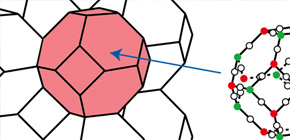
Successful Observation of Mössbauer Absorption of Potassium Nucleus by Using Synchrotron Radiation
Clarifies the mechanism of an exotic magnetism of nanoparticles and opens the ability of the new microscopic probe
A research group led by Takehito NAKANO (Assistant Professor, Graduate School of Science, Osaka University), Makoto SETO (Professor, Research Reactor Institute, Kyoto University), and Yoshitaka YODA (Principal Researcher, Japan Synchrotron Radiation Research Institute) succeeded in observing Mössbauer absorption spectra of potassium nucleus by using a synchrotron-radiation light source for the first time. They clarified the origin of an exotic magnetic property of a periodic array of potassium metal nanoparticles in a porous crystal. The experimental technique is applicable to any kinds of materials containing the abundant element potassium, and will be a powerful tool in various scientific fields such as physics, chemistry, materials science, biology, and earth science to investigate the local environment of the atoms in the condensed matter.
The Mössbauer effect is known as the recoilless absorption/emission of gamma rays. The Mössbauer spectroscopy is widely used in various research fields to investigate in detail the local environment of the specific element. Usually, to perform the experiment, radioisotopes are necessary as the gamma ray source. A potassium isotope 40 K is also known as a nucleus in which the Mössbauer effect has been observed. However, there are no appropriate radioactive parent nuclides. Thus, it is extremely difficult to perform the Mössbauer spectroscopy because it is impossible to use the ordinary method. In the present paper, the authors succeeded in observing the Mössbauer absorption spectra of 40 K by using a synchrotron-radiation light source for the first time. The method is much more efficient than the previous experiments by utilizing nuclear reactions that were performed 50 years ago. Potassium is a very abundant element in the surface of the earth and is contained in various kinds of important materials. The achievements in this paper may contribute to a broad range of scientific areas because the method is applicable to any materials containing potassium.
The material investigated in this paper is also unique. Generally, magnetic materials contain transition metal or rare-earth metal elements because they can possess magnetic moments. However, the material in this paper does not contain any “magnetic elements”. Potassium nanoparticle holds the key of the magnetic property. As shown in Fig. 1, the potassium nanoparticles are formed in the nano-sized cages in a porous crystal of sodalite. The magnetic ordering is realized by the mutual interaction between the electron “clouds” in the periodically arrayed nanoparticles. In this paper, the authors obtained the Mössbauer spectra of the potassium nuclei in the nanoparticles. The data directly evidence that the electron “cloud” in the nanoparticle is the origin of the magnetism in this material. These findings can contribute to the science of how we can design intelligent materials with using only abundant elements, which may lead to a development of human society.
Figure 1. Schematic illustration of (a) porous crystal of sodalite with nano-sized cage and (b) potassium nanoparticle formed in the cage. An electron “cloud” is shared among four potassium ions. Mössbauer spectroscopy was performed by using a synchrotron-radiation light of SPring-8, which was adsorbed by the potassium nucleus at the center of the ion. The obtained data directly evidence that the electron “cloud” in the nanoparticle is the origin of the magnetism in this material.
Fig. 2. Mössbauer spectrum of potassium nucleus ( 40 K) measured by using synchrotron radiation.
To learn more about this research, please view the full research report entitled “ Synchrotron-radiation-based Mössbauer spectroscopy of 40 K in antiferromagnetic potassium nanoclusters in sodalite ” at this page of the Physical Review B website.
Related link

